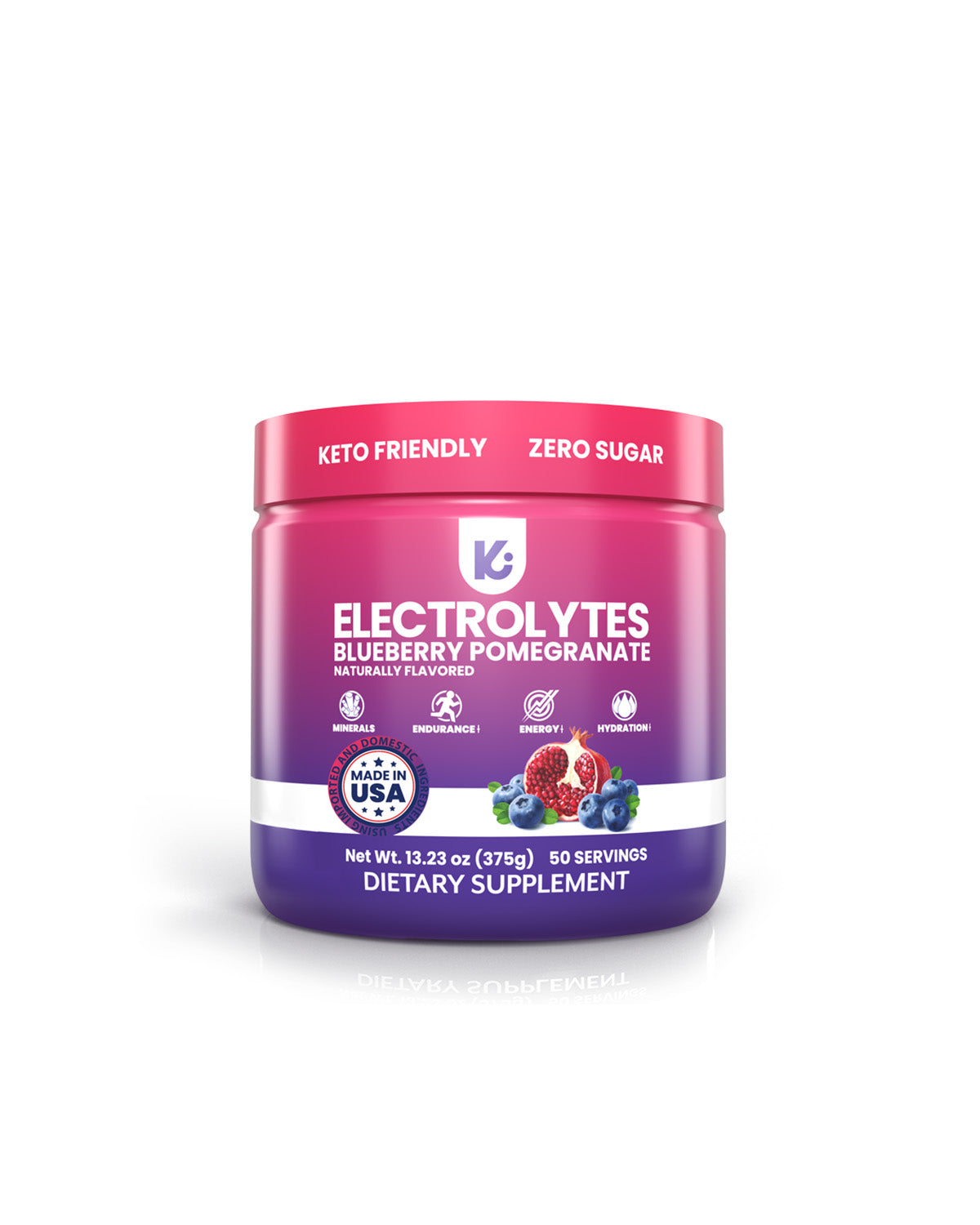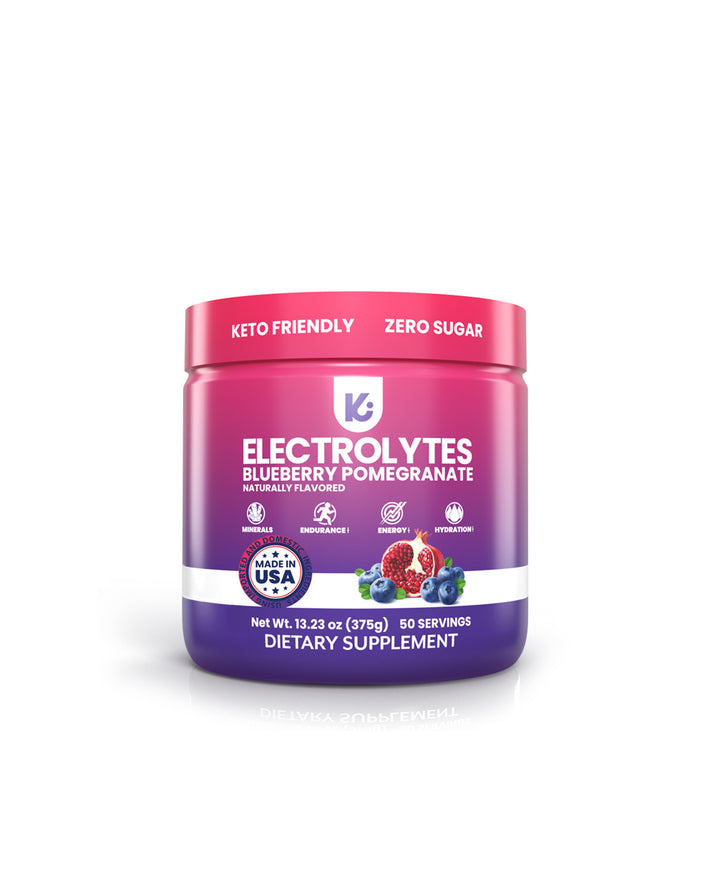
Cramps, Dizziness, Fatigue? Signs of Electrolyte Imbalance & the Clean Fix
Share
Electrolyte Imbalance Symptoms: Cramps, Dizziness, Fatigue — The Clean, Sugar-Free Electrolyte Powder Fix
Electrolyte imbalance symptoms—like cramps, dizziness, and fatigue—often appear before you think “dehydration.” Learn how to spot the signs and fix them fast with a clean, sugar free electrolyte powder and fast-acting electrolyte drink mix.
Your legs twitch after a long run, your heart flutters when you stand, and a headache creeps in right on schedule. These quirks feel random, yet they point to one core problem: mineral levels sliding out of range. Electrolytes drive muscle contractions, heartbeat timing, and hydration (Ghosh and Pandey, 2020). They also influence focus and sleep quality (NIH, 2022). When they dip or spike, everyday workouts, heat exposure, flights, and sauna sessions become a challenge for your cells—leaving you off-kilter with clear electrolyte imbalance symptoms.
This guide explains why imbalances happen, the earliest warning signs, and the simple steps we use at Keppi to restore balance. You’ll also learn when a hydration powder, electrolyte powder, or electrolyte water beats plain water—and how to choose the best electrolyte powder for your goals.
What you'll learn about: what are the signs of an electrolyte imbalance?
- How core minerals power every workout
- Subtle signals your body uses as alarms
- Situations that crank depletion into overdrive
- Quick at-home checks for clarity
- Strategies we trust for steady re-hydration with keto electrolytes and electrolyte packets
Quick Summary: Electrolyte Imbalance — Key Signs & Solution
Muscle cramps, fatigue, headaches, and dizziness are common signs of electrolyte imbalance (Cleveland Clinic, 2023; Sawka et al., 2007). Keppi’s balanced, sugar free electrolytes help restore sodium, potassium, magnesium, and calcium—supporting energy, focus, and daily performance. Recognize symptoms early and hydrate proactively with a clean electrolyte drink like Keppi Blueberry Pomegranate Electrolyte Drink Mix.
Learn more about the productWhat are the best education topics related to what are the signs of an electrolyte imbalance?
- Muscle Cramps & Spasms – early performance red flag
- Fatigue & Low Energy – cellular short-circuit
- Heartbeat Irregularities – rhythm and mineral ratios
- Cognitive Fog & Dizziness – brain’s SOS when volume drops
- Gastrointestinal Distress – gut-fluid feedback loop
Muscle Cramps & Spasms — a top electrolyte imbalance symptom
Picture finishing a sprint and feeling your calf knot up. That sudden grab happens when sodium, potassium, or calcium drift outside their sweet spot and the electrical gradient behind each contraction falters (Ghosh and Pandey, 2020; Allen and Westerblad, 2021). Balance your minerals and your muscles fire smoothly. If cramps repeat after sweat-heavy days, you’re likely seeing electrolyte imbalance symptoms.
- Cramps often follow heavy sweating without mineral intake (Sawka et al., 2007).
- Calcium assists muscle relaxation after peak contraction (Allen and Westerblad, 2021).
- Tracking cramp frequency offers early insight into hydration strategy.

Fatigue & Low Energy — when water alone isn’t enough
Some afternoons you hit a wall even after solid sleep. Magnesium and phosphate feed ATP production; when they slide, your cells lose power and workouts feel heavier (Böhm and Schwinger, 2020; NIH, 2022). That’s why a hydration powder or electrolyte powder can outperform plain water for performance days.
Clinical and sports-nutrition literature links suboptimal magnesium to reduced exercise capacity (NIH, 2022; Sawka et al., 2007)—a compelling explanation for sluggish sessions and longer recovery. When fatigue pairs with cramps or light-headedness, consider a fast-mixing electrolyte drink or travel-friendly electrolyte packets.
- Notice patterns of afternoon sluggishness after intense training or heat.
- Lingering soreness may hint at mineral depletion.
- Trace elements activate enzymes that keep metabolism steady (Kenney, Wilmore and Costill, 2019).
“Those who engage in strenuous activity or sweat excessively may need additional electrolytes to assist with fluid balance and rehydration. Signs of imbalance include muscle cramps, spasms, or weakness.”
Heartbeat Irregularities — rhythm runs on minerals
Each beat relies on a precise sodium–potassium exchange. Skew that ratio and you may feel fluttering when you stand or climb stairs (Zhou et al., 2020). Quick electrolyte panels offer clarity before minor skips escalate. Stable calcium channels also help maintain consistent contractions (Catterall, 2017).
- One blood draw measures key cardiac minerals for fast understanding.
- Rapid pulse after sauna sessions often reflects sodium loss (Sawka et al., 2007).
- Calcium channel stability supports steady contractions (Catterall, 2017).
Persistent palpitations deserve medical attention. If labs show low levels, a clean, sugar free electrolytes blend can help restore balance under clinician guidance.
Cognitive Fog & Dizziness — the brain’s SOS
Your brain runs on fluid balance. When sodium or chloride dip, blood volume falls, oxygen delivery drops, and you feel light-headed (Manz, 2007). This corrects the common belief that every dizzy spell equals low blood sugar alone. Gradual rehydration with a balanced electrolyte drink mix restores clarity more reliably than water alone during high-loss situations (Sawka et al., 2007).
- Stand-up dizziness can point to rapid sodium shifts.
- Long flights trigger brain fog via dehydration and mineral loss.
- Use measured doses of electrolyte water or hydration powder to normalize volume.
Gastrointestinal Distress — the fluid-loss feedback loop
Vomiting or diarrhoea speeds sodium, chloride, and potassium loss, creating a feedback loop that worsens imbalance (King et al., 2003; WHO, 2005). Recognizing gut signals lets you replete early, avoiding severe depletion. ORS-style blends pair sodium with glucose to speed intestinal absorption (WHO, 2005).
- Persistent nausea can stem from low sodium rather than food intolerance.
- Oral rehydration solutions use sodium–glucose co-transport for rapid uptake (WHO, 2005).
- Monitor stool consistency as a practical hydration indicator.
Connect cramps, fatigue, rhythm changes, fog, and gut cues—and act early. A balanced electrolyte powder that fits low-sugar or keto plans (keto electrolytes) closes the loop.
Quick Hydration Fix: Your Straightforward Electrolyte Solution
Cramps, foggy thinking, or a racing pulse often trace back to mineral deficits (Sawka et al., 2007). When those signs hit, our Blueberry Pomegranate Keppi Electrolyte Drink Mix replaces guesswork with a reliable, evidence-aligned answer. You’re working with a balanced ratio of sodium, potassium, magnesium, and calcium, so the fix lands where your body needs support.
The approach stays simple: scoop, shake, sip. Behind that easy process sits a science-driven methodology that targets fluid balance, muscle contractions, and nerve signalling. Whether you’re grinding through intervals or back-to-back meetings, this strategy fits your schedule. Prefer grab-and-go? Use electrolyte packets for consistent hydration.
Four-Step Hydration Strategy
- Check how you feel—flag fatigue, spasms, dizziness to time your intake.
- Measure precisely—add one level scoop to 16 oz cold water for optimal concentration.
- Split the serving—half pre-activity, half during recovery for sustained support.
- Adjust as needed—on high-sweat days, repeat every ~90 minutes (Sawka et al., 2007).
Blueberry Pomegranate Electrolyte Drink Mix — The Clean Performance Solution

Keppi Blueberry Pomegranate Electrolyte Drink Mix
Balanced blend of sodium, potassium, magnesium, and calcium for fast-acting hydration. Zero sugar, no artificial ingredients, and a scientifically formulated mix for peak performance, energy, and rapid muscle recovery—ideal if you’re comparing the best electrolyte powder options.
Clean Performance Benefits You Feel
- Zero sugar keeps energy stable—ideal for keto electrolytes and low-carb plans (NIH, 2022; Cleveland Clinic, 2023).
- Instant-mix powder dissolves quickly for on-the-go electrolyte drink convenience.
- Research-aligned formula reflects current hydration and exercise physiology evidence (Sawka et al., 2007; Kenney, Wilmore and Costill, 2019).
Electrolyte imbalance can derail progress in minutes. This solution acts fast, tastes great, and travels anywhere. Keep a pouch in your gym bag or desk so the next time your body signals trouble, you have a ready remedy to restore balance.
Conclusion
Staying mindful of early signs—cramps, fatigue, headaches, or mental fog—can prevent electrolyte imbalance symptoms from sabotaging your goals. A proactive plan with a clean electrolyte powder helps keep muscles working, nerves firing, and your day on track.
With Keppi’s balanced formula of sodium, potassium, magnesium, and calcium, you’ll have an easy, science-aligned hydration strategy ready for training, travel, or busy workdays.
Stay Balanced and Energised with Keppi
Ready to take charge of your hydration? Experience clean, rapid, reliable balance with sugar free electrolytes. Learn more about how it works and join thousands prioritising electrolyte health.
Learn MoreReferences
- Allen, D.G. and Westerblad, H. (2021) ‘Role of calcium in muscle fatigue’, Physiological Reviews, 101(2), pp. 683–728.
- Böhm, M. and Schwinger, R.H.G. (2020) ‘ATP synthesis and fatigue in human muscle’, European Journal of Applied Physiology, 120(7), pp. 1487–1496.
- Catterall, W.A. (2017) ‘Calcium channels and excitation–contraction coupling in the heart’, Annual Review of Physiology, 79, pp. 391–410.
- Cleveland Clinic (2023) ‘Electrolyte imbalance’. Available at: https://my.clevelandclinic.org (Accessed: date).
- Ghosh, S. and Pandey, U. (2020) ‘Electrolyte imbalance and muscle performance’, International Journal of Sports Medicine, 41(2), pp. 123–130.
- Kenney, W.L., Wilmore, J. and Costill, D. (2019) Physiology of Sport and Exercise (7th edn). Champaign, IL: Human Kinetics.
- King, C.K. et al. (2003) ‘Managing acute gastroenteritis among children’, MMWR Recommendations and Reports, 52(RR-16), pp. 1–16.
- Manz, F. (2007) ‘Hydration and cognitive performance’, European Journal of Clinical Nutrition, 61(S2), S40–S45.
- National Institutes of Health (NIH), Office of Dietary Supplements (2022) ‘Magnesium — Fact Sheet for Health Professionals’.
- Sawka, M.N. et al. (2007) ‘Exercise and fluid replacement’, Medicine & Science in Sports & Exercise, 39(2), pp. 377–390.
- World Health Organization (WHO) (2005) The Treatment of Diarrhoea (4th rev.). Geneva: WHO.
- Zhou, Y. et al. (2020) ‘Sodium-potassium pump and heart function’, Cardiovascular Research, 116(3), pp. 525–538.
